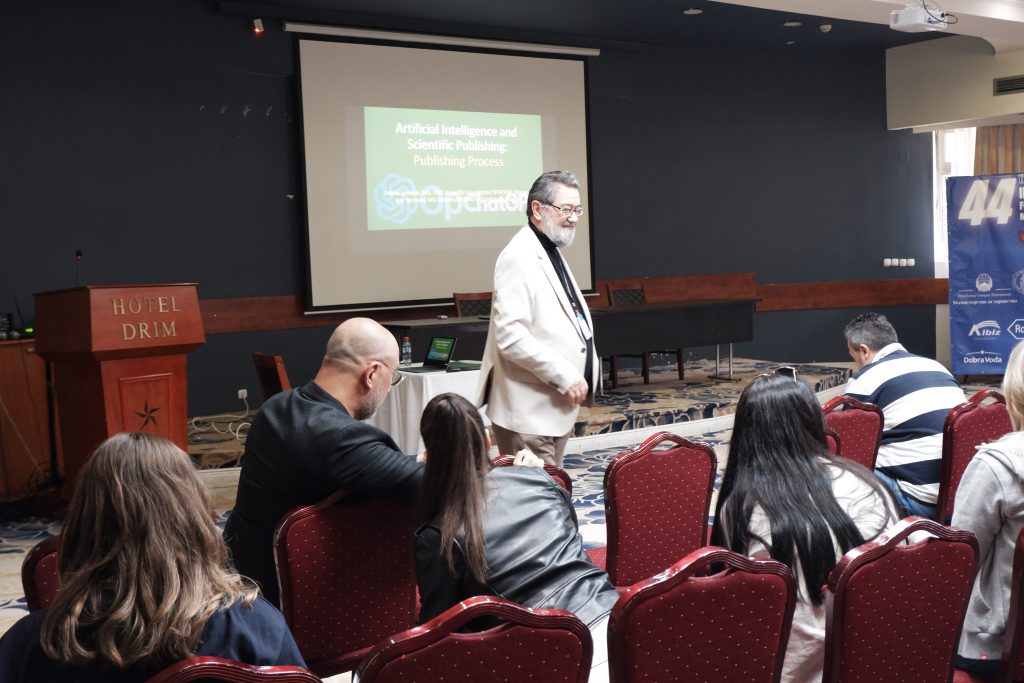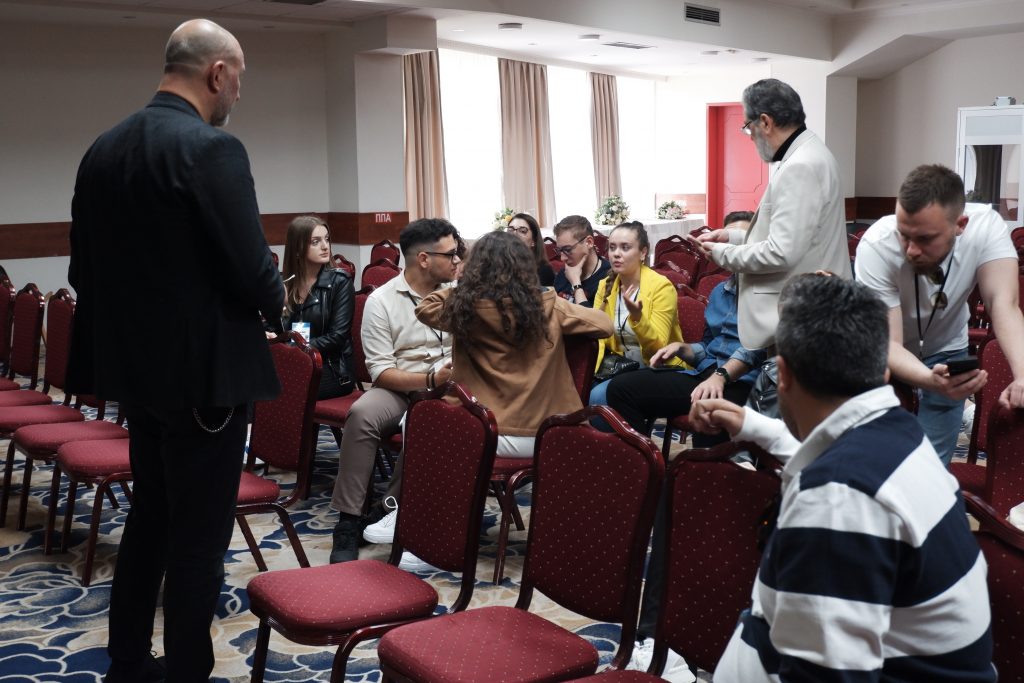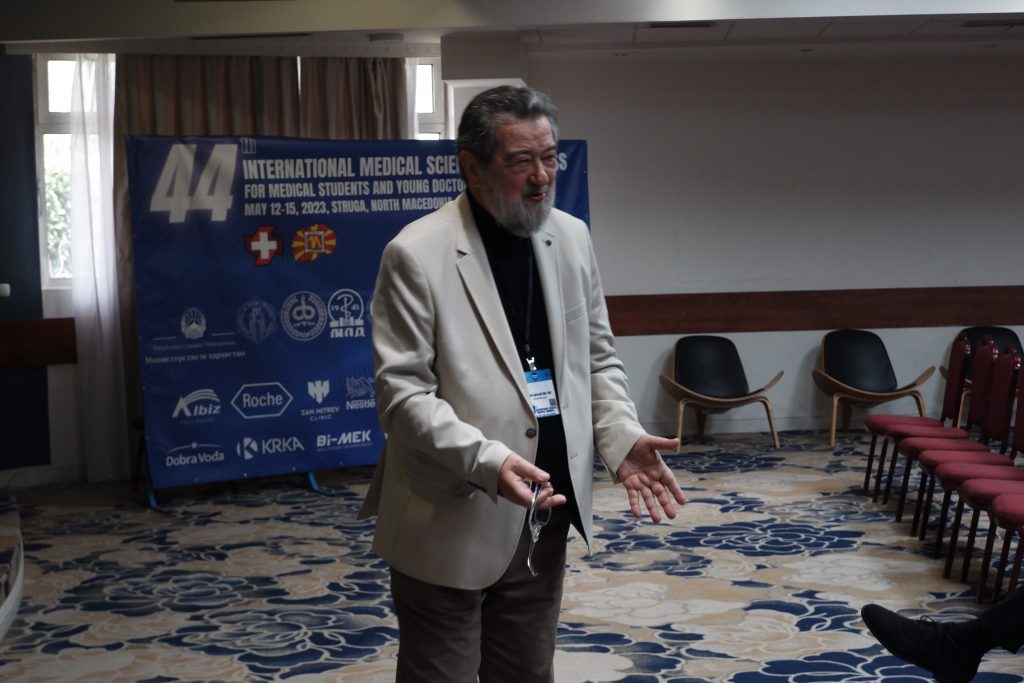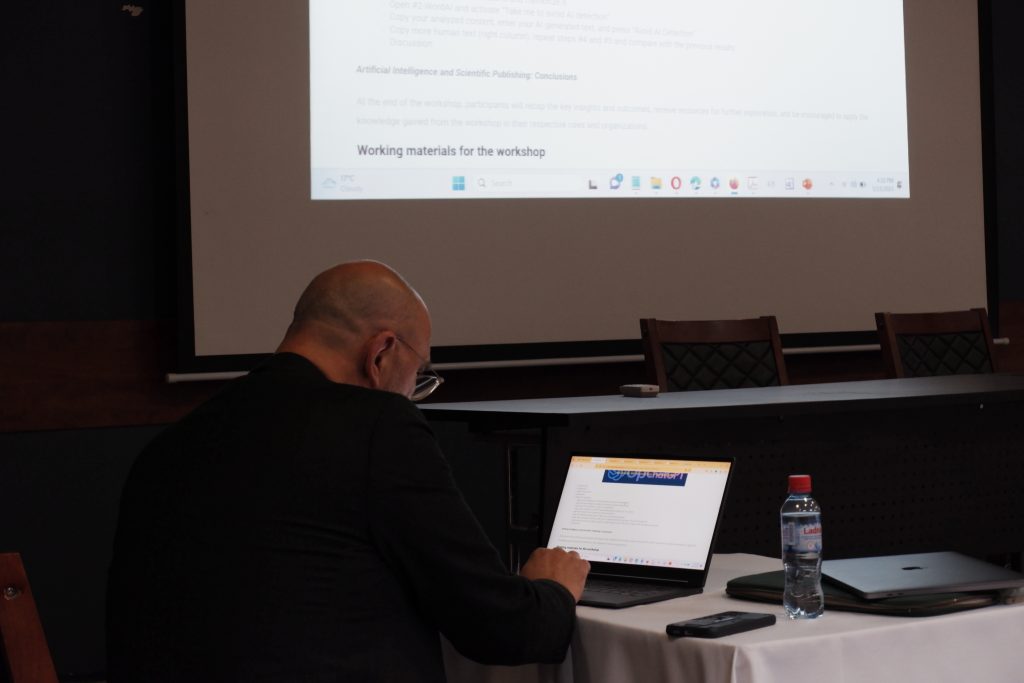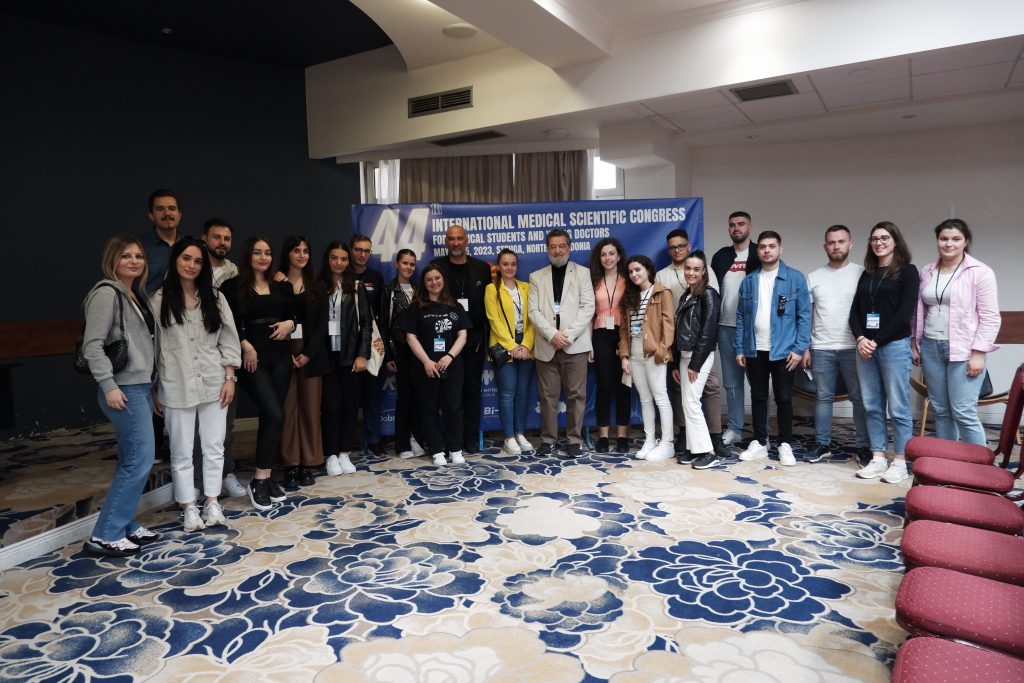ARTIFICIAL INTELLIGENCE AND SCIENTIFIC PUBLISHING
44th International Medical Scientific Congress organized by @mmsamacedonia May 12-15, 2023, Struga, North Macedonia
Mirko Spiroski1, Igor Spiroski2
1Scientific Foundation SPIROSKI, Skopje, Republic of North Macedonia; 2University Clinic of Cardiology, Medical Faculty, Skopje, Republic of North Macedonia
Abstract
Artificial intelligence (AI) is a rapidly growing field that has the potential to revolutionize many industries, including scientific publishing. In recent years, there has been a growing interest in using AI techniques to assist with various aspects of the scientific publishing process. This paper provides an overview of the current state of AI in scientific publishing, including the use of natural language processing (NLP) to extract and analyze data from scientific publications, the use of machine learning (ML) algorithms to assist with peer review and plagiarism detection, and the use of AI-powered recommendation systems to help researchers discover relevant publications. We also discuss the potential benefits and challenges of using AI in scientific publishing, including concerns around data privacy and bias. Overall, AI has the potential to greatly improve the efficiency and accuracy of the scientific publishing process, but careful consideration must be given to the ethical and societal implications of its use.
Keywords: Artificial intelligence (AI), scientific publishing, natural language processing (NLP), machine learning (ML) algorithms

Outline Workshop for Artificial Intelligence and Scientific Publishing
Artificial Intelligence and Scientific Publishing:
Scientific publishing is an essential part of the research ecosystem. Artificial intelligence (AI) has the potential to accelerate scientific research and improve the publication workflow. This workshop will provide an overview of AI in scientific publishing, discuss its benefits and challenges, and explore strategies for practical implementation.

- Early History
- The Turing test
- Artificial intelligence
- AI versus machine learning versus deep learning
- Deep learning
- Neural network
- Artificial Neural Network
- Where is AI used
- AI use case in healthcare
- AI chatbots in healthcare
- What is ChatGPT?
- OpenAI
- Language model
- Conversational AI
- Training data
- Ethical Concerns of ChatGPT
- Free/Paid versions of ChatGPT
- Tasks for students
- Install ChatGPT open AI [https://chat.openai.com/auth/login] on laptop
- Install AI chat on mobile “Open Chatbot – AIAssistant”
Artificial Intelligence and Scientific Publishing:

- International standard for medical journals
- Classification of scientific papers
- Structured abstracts
- Structure of scientific papers
- Citation styles of the literature
- Steps in the traditional publishing process
- Tasks for students and discussion
- Compose manuscript for Case report
- Compose manuscript for Narrative review
- Compose manuscript for Systematic review
- Prepare Review for the manuscript
Artificial Intelligence and Scientific Publishing:
Using AI in scientific publishing poses challenges such as bias, accuracy, and reproducibility. Ethical concerns include AI-generated content, authorship, and plagiarism detection. The workshop will address these challenges and provide best practices for responsible AI use in scientific publishing.

- Authorship
- Plagiarism
- More human text
- Standards
- Tasks for students
- Open account [https://contentatscale.ai/ai-content-detector/]
- Open account [https://wordai.com/pass-ai-content-detection]
- Copy part of an article or copy our example []
- Place your content in the #1-Contentatscale and check for AI content
- See how robotic your content is and memorize it
- Open #2-WordAI and activate “Take me to avoid AI detection”
- Copy your analyzed content, enter your AI generated text, and press “Avoid AI Detection”
- Copy more human text (right column), repeat steps #4 and #5 and compare with the previous results
- Discussion
Artificial Intelligence and Scientific Publishing: Conclusions
At the end of the workshop, participants will recap the key insights and outcomes, receive resources for further exploration, and be encouraged to apply the knowledge gained from the workshop in their respective roles and organizations.
Working materials for the workshop
Prompts for writing “Case Report”

Please, generate a case report article for a medical journal about the case described below.
Case report
A 35-year-old male patient presented to the emergency room with severe chest pain that started 2 hours ago during a strenuous cycling exercise at a distance of 11km. He didn’t have a past medical history, or a family history for cardiovascular diseases. He was a nonsmoker and physically active, regularly cycling for 12-20 km per day. One month before hospitalization he experienced Covid-19 like symptoms with dyspnea and anosmia, but without confirmation with a PCR test for Covid-19, while two weeks before admission he has had his first anti-Covid-19 vaccine.
On physical examination, his blood pressure was 140/90mmHg and a heart rate of 90/min. The electrocardiogram showed sinus rhythm with a heart rate of 93/min, normal heart axis and ST segment elevation of 3mm in the inferior leads (D2, D3, aVF).
Figure 1. ECG on admission showing ST segment elevation in inferior leads
An urgent coronarography was indicated which showed thrombotic formations in the proximal part of the right coronary artery (pRCA), right postero-descending artery (rPDA) and right postero-lateral artery (RPL) without atherosclerotic plaques. Percutaneous coronary intervention with plain old balloon angioplasty (PCI/ POBA) and thrombus aspiration with Export 6 catheter was performed, which was followed by a dose of GP IIb/IIIa inhibitor i.v. bolus and infusion, afterwards continuing with infusion of unfractionated heparin for 24 hours in addition to antiplatelet treatment.
Figure 2. Coronarography showing thrombotic formations in pRCA, rPDA and RPL
Figure 3. PCI/POBA and thrombus aspiration.
The initial blood analysis showed mildly increased values of hs troponin I – 32,87ng/ml, which increased up to 13 132 ng/ml on the second day of hospitalization and returned to normal values before discharge. From the additional blood work, a D-Dimer test was performed showing elevated values to 2237 ng/ml.
Transthoracic echocardiography revealed normal dimensions, systolic and diastolic function of the left ventricle with EF-60%. There was dyskinesia on the basal segment of the inferior wall of the left ventricle.
Additional genetic tests were warranted due to the unknown cause of this event. Molecular genetic test by the method of reverse hybridization on the DNA isolated from the leukocytes of the peripheral blood showed the patient to be heterozygous for factor V Leiden and homozygous for methylenetetrahydrofolate reductase (MTHFR) C677T gene mutation.
After eight days of hospitalization, the patient was discharged in a good clinical condition with a recommendation for medical treatment including a prophylactic dose of direct oral anticoagulation and antiplatelet treatment.
After one-year follow-up, the patient had no symptoms or recurrent cardiovascular events and was continued on prophylactic dose of NOAC.
The journal article should contain the following sections and References should be cited in the text with Vancouver style:
Introduction (maximum 300 words)
Illustrative case
Discussion (maximum 600 words)
Conclusion (maximum 150 words)
References
Additional prompts:
Continue
Please, include references in the text
please, prepare abstract with Background, Case presentation, Conclusions, Key words
Prompts for writing “Narrative Review”
Prepare narrative review for “Unrelated Stem Cell Transplantation in the Republic of Macedonia”:
Abstract with Background, Aim, results, Discussion, Conclusion, Keywords;
Introduction with citing references in the text with Vancouver style;
Conclusion
Complete list of references with Vancouver style
Additional prompts:
Continue
Prompts for writing “Systematic Review”
Prepare Systematic review for the “HLA in Macedonian Population”
Abstract with BACKGROUND, AIM, METHODS, RESULTS, CONCLUSION, KEYWORDS
Cite references in the text Vancouver style
Introduction (maximum 400 words); Methods (maximum 600 words); Results (maximum 1000 words); Discussion (maximum 600 words); Conclusions (maximum 250 words); References
Additional prompts:
Continue
Please, prepare Table
Prompts for writing “Review for the article”
I need help reviewing a scientific paper entitled “Chronic rhinosinusitis with polyps and comorbid asthma: results of reslizumab treatment“
Transition from standardization to personalized treatment have led to the separation of such heterogeneous diseases as asthma and chronic rhinosinusitis (CRS) into clinically similar groups called phenotypes. From the clinical viewpoint CRS is commonly divided into two phenotype-based groups on the presence (CRSwNP) or absence of nasal polyps (CRSsNP). The first phenotype is associated with eosinophilic or Th2-polarized inflammation while the second – with neutrophilic or non-Th2-polarized one [1]. In 80-90% of patients suffering from CRS with polyps, a significant systemic and local eosinophilia is identified, along with an increase in the local level of Th2-dependent cytokines, such as interleukin 4, 5, 9, 13, 25, 33 (IL-4, IL-5, IL-9, IL-13, IL-25, IL-33), increased expression of the receptors to IL-5 and local production of immunoglobulin E (IgE), while the key mediator of eosinophilic inflammation is IL-5, which provides activation, chemotaxis and survival of eosinophils [2]. In the international consensus document EPOS 2020 [3], a new classification was proposed, according to which chronic rhinosinusitis is divided into primary and secondary, and each of these groups is divided, depending on the prevalence of the process, into localized and diffuse forms of CRS. Diffuse primary chronic rhinosinusitis is divided by the nature of the dominant inflammatory endotype into 2 groups: type 2 (Th2 type) and non-type 2 (non-Th2 type). The Th2 type group includes chronic rhinosinusitis with nasal polyps/eosinophilic rhinosinusitis, allergic fungal rhinosinusitis and central compartment allergic disease; the non-Th2 type group includes non-eosinophilic rhinosinusitis. CRS with polyps is often combined with asthma. In patients with asthma, CRSwNP is detected in 7-16% of cases and more than 80% have X-ray signs of inflammatory diseases of the paranasal sinuses [4, 5], while in 26-48% of patients with CRSwNP the concomitant disease is asthma [6, 7]. These comorbid diseases mutually burden each other: on the one hand, asthma in patients with CRSwNP is much more severe [8, 9], on the other hand, this group of patients is characterized by more frequent reсurrence of polyps after surgical treatment [10]. Asthma is also a group of clinical variants that differ in pathophysiological parameters, the type and severity of inflammation, the response to corticosteroid therapy, and many other factors. Currently there are several phenotypes of asthma: allergic, non-allergic (eosinophilic), asthma with permanent obstruction, infection-dependent, asthma with late onset, asthma associated with obesity [11, 12]. Inflammation in eosinophilic asthma has similar features to that in patients having CRSwNP: an increased content of eosinophils in the mucosa, in sputum and in blood, Th2-type of inflammatory reaction with hyperproduction of IL-5 and eosinophil cationic protein (ECP) [13]. In the last decade, a new promising direction has appeared in the treatment of asthma – targeted therapy with humanized monoclonal antibodies (biologics) [14, 15]. The correlation between the severity of CRSwNP and eosinophilic asthma, the proximity of the endotypes of these diseases [16] along with the successful use of biologics for the treatment of severe asthma [14] explain the interest in the research of the possibility of using this group of drugs in patients with CRSwNP [17, 18, 19, 20]. Objective. The aim of the research was to study the dynamics of nasal symptoms in patients with CRSwNP combined with asthma during reslizumab treatment. Reslizumab is a humanized monoclonal antibody with a high affinity for IL-5. Reslizumab specifically binds to IL-5, causing a restriction of differentiation, chemotaxis, activation and survival of eosinophils [21, 13], thereby reducing the level of eosinophilic inflammation and remodeling of the respiratory tract. Discussion. In our research we have evaluated the dynamics of nasal symptoms when using reslizumab in patients with severe eosinophilic asthma. The presence of CRSwNP was detected in 15 of the 18 studied patients, 3 patients had symptoms of chronic rhinitis as a manifestation of NARES. Changes in the CT were present in 100% of cases. Along with a noticeable improvement in asthma control, which was confirmed by studies of lung function, patients showed clinical, endoscopic, radiological signs of a decrease in the severity of nasal symptoms. The improvement in the quality of life was confirmed by the results of SNOT-22, which revealed a decrease in symptoms such as rhinorrhea, nasal obstruction, hyposmia and sleep disorders. The data of endoscopic examination revealed a reduction of polyps in 1 out of 15 patients, which indicates the possibility of reverse development of remodeling of the nasal mucosa during targeted therapy. No positive dynamics of nasal symptoms and the course of asthma was noticed in one patient with AERD. In the case of another patient control over asthma symptoms was achieved (an increase in AST from 8 to 22 and FEV1 from 86% to 106%), however the growth of polyps continued (TPS increased from 2 to 5). The improvements observed in patients with CRSwNP and comorbid asthma testify that reslizumab affects eosinophilic inflammation of both the lower and upper respiratory tracts. The results of our clinical study coincide with the conclusions of earlier observations [18, 23]. In the literature there is certain evidence that the presence of polyps in patients with eosinophilic asthma allows predicting a positive result in the treatment with reslizumab. Thus, S. F. Weinstein et al. [5] performed a retrospective analysis of the patient-reported medical histories of 953 patients with inadequately controlled asthma treated with reslizumab for 52 weeks. 150 patients (16%) had self-reported CRSwNP, endoscopic examination of the nasal cavity and CT of the paranasal sinuses were not conducted. Despite these serious limitations, the authors proved that patients with CRSwNP were highly responsive to treatment with reslizumab. We also noted more significant positive changes in AST and spirometry indicators in patients having CRS with nasal polyps. Patients without nasal polyps with recurrent symptoms of rhinitis (rhinorrhea, sneezing, nasal congestion) are of particular interest. These patients were observed for a long time with a diagnosis of allergic rhinitis. However, the detected eosinophilia of the rhinocytogram (up to 75%), an increase in the ECP content in the blood and at least twice the negative results of the allergic tests allowed us to diagnose these patients with NARES. In the group of patients with CRS with nasal polyps, it was possible to detect the anamnestic presence of similar symptoms at the beginning of the disease. These results confirm the previously suggested assumption that NARES may be a predictor of the development of AERD, non-IgE-related asthma and nasal polyps [24]. The study of the cytokine profile of inflammation clarifies the pathogenetic features of various phenotypes of the disease, which determines the direction of targeted therapy [25, 6, 26]. However, the studies of the content of cytokines in the tissues of polyps and the nasal mucosa [6] are currently beyond the scope of practical health care. Today the prediction criterion for the effectiveness of reslizumab is an increase in the number of eosinophils in the blood of more than 400 cells/ml. Further studies of the use of monoclonal antibodies should reveal additional clinical criteria for the selection of patients with CRS with polyps for the use of this group of drugs. Conclusions. Reslizumab treatment of patients with eosinophilic asthma and concomitant chronic rhinosinusitis with nasal polyps and chronic non-allergic rhinitis (NARES) leads not only to improved control of asthma symptoms, but also to a significant regression of nasal symptoms. Clinical significance. Currently, the indications for the treatment of chronic rhinosinusitis with polyps have been registered in dupilumab alone. Studies of the effects of other biologics can not only expand the their indications, but also identify possible advantages in the selection of drugs for the treatment of different types of CRS.
Samples for checking AI plagiarism
Discussion
In our case, the patient had weak risk factors for VTE, which highlights the importance of considering VTE as a possible diagnosis even in patients with low risk factors. Previous studies have shown that up to 30% of patients with VTE have no identifiable risk factors, making it essential to maintain a high index of suspicion [4].
Cardiac MRI has been shown to be an effective diagnostic tool for identifying pulmonary embolism. A study by Konstantinides et al. found that cardiac MRI had a sensitivity and specificity of 96% and 100%, respectively, for detecting acute pulmonary embolism [5]. In addition, cardiac MRI has been shown to have high diagnostic accuracy in detecting right ventricular dysfunction, which is a predictor of poor outcomes in patients with pulmonary embolism [6].
Non-invasive multimodality imaging may provide a better solution to overcome the limitations of the independent techniques. In our case, cardiac MRI was used as an alternative to transthoracic echocardiography (TTE), which was not feasible due to poor echogenicity. Cardiac MRI allowed us to rule out myocarditis and identify filling defects in the main pulmonary arteries, which led to the diagnosis of pulmonary embolism.
In terms of treatment, anticoagulation is the standard of care for patients with pulmonary embolism. Direct oral anticoagulants (DOACs) have been shown to be non-inferior to traditional anticoagulants, such as warfarin, in the treatment of pulmonary embolism and have the added benefit of not requiring regular laboratory monitoring [7]. In our case, the patient was treated with LMWH for 7 days followed by rivaroxaban, a DOAC, according to a PE protocol.
Conclusion
Overall, our case highlights the importance of maintaining a high index of suspicion for pulmonary embolism in patients with non-specific symptoms, even in those with low risk factors. It also demonstrates the utility of cardiac MRI as a diagnostic tool for pulmonary embolism when TTE is not feasible. Finally, our case illustrates the efficacy of DOACs in the treatment of pulmonary embolism.
Samples for checking AI humanization
Discussion
Our patient presented with only modest risk factors for VTE, underscoring the importance of considering it as a potential diagnosis even among those with minimal risks. Studies have revealed that up to 30% of VTE sufferers may lack identifiable risk factors [4]. [
Cardiac MRI has proven itself an effective diagnostic tool for detecting pulmonary embolism. A study by Konstantinides et al. demonstrated that cardiac MRI had a sensitivity and specificity of 96% and 100% respectively when applied to acute pulmonary embolism detection [5]. Furthermore, cardiac MRI also has proven effective at identifying right ventricular dysfunction – which has been shown to predict poor outcomes among those suffering pulmonary embolism patients [6].
Noninvasive multimodality imaging may provide a superior way of overcoming the limitations of individual techniques. In our case, cardiac MRI was utilized as an alternative to transthoracic echocardiography (TTE), which could not be performed due to poor echogenicity. Cardiac MRI enabled us to rule out myocarditis while also identifying filling defects in main pulmonary arteries resulting in the diagnosis of pulmonary embolism.
As for treatment, anticoagulation remains the standard of care for patients suffering pulmonary embolism. Direct oral anticoagulants (DOACs) have proven non-inferior to traditional anticoagulants like warfarin in treating PEs; additionally they do not require regular laboratory monitoring [7]. Our patient was prescribed an initial course of LMWH followed by DOAC Rivaroxaban according to an approved PE protocol.
Conclusion
Our case illustrates the importance of maintaining a high index of suspicion for pulmonary embolism even among patients who present nonspecific symptoms but possess low risk factors, and shows cardiac MRI’s use as a diagnostic tool when TTE isn’t feasible. Furthermore, DOACs demonstrated their efficacy against this form of embolism treatment.

